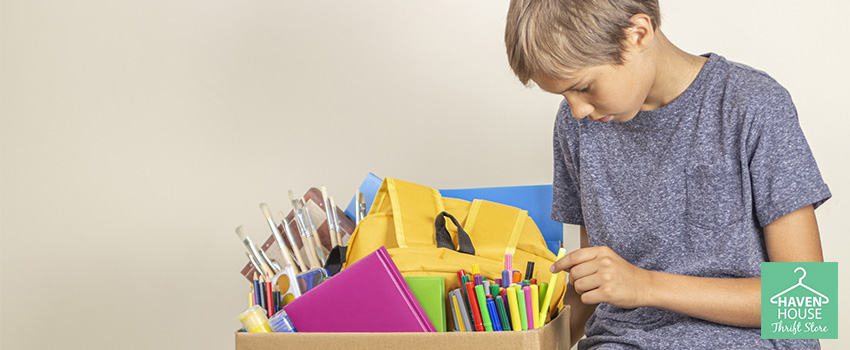Used clothes have a big environmental impact.
When you raid your closet, you sort your clothes into three categories: keep, donate, and toss. Even though most clothes get donated, others end up in landfills. According to the U.S Environmental Protection Agency, Americans generate over 16 million textile waste.
If you don’t know what to do with unwanted clothes, Haven House is here to enlighten you. Find out what happens to clothes you no longer want, where to drop off unwanted clothes, and more.
What Happens to Clothes You No Longer Want?
If you’re someone who declutters their closet once in a while, then you might have wondered where your used clothes end up. Even though people donate most of their clothes, a shocking number still end up in the U.S. waste stream. Here are the numbers:
- 13% of the U.S. waste stream consist of plastic waste
- 6% of the total municipal waste is textile waste
- 700,000 tons of unwanted clothes gets imported abroad
- 2.5 million tons go through the recycling process
- 3 million tons are burned
- 10 million tons end up in landfills
As an individual, you can do the following:
- Reduce textile waste
- Prevent clothes from ending up in landfills
- Prevent them from getting burned
All of these processes increase greenhouse gas emissions, which harm the environment. Another thing is that it costs around $45 to dispose of a ton of textile. When you do the math, it takes hundreds of millions of dollars annually.
If you know where to sell unwanted clothes or where to drop them off, know that it is not the end for those clothing pieces. Finding them a new owner doesn’t mean their lifespan has ended.
What to Do With Unwanted Clothes?
You can do several things with clothes that you no longer want or no longer fit you. Here are some things people do with them:
Donation
Other people’s idea is to sell unwanted clothes; others find a local charity shop in their area to donate. When you do this, it opens up an opportunity for the clothes to be resold. However, around 5% of clothing donations are sent to landfills because of mildew issues.
When there are traces of mildew — even on one piece of clothing — it may contaminate bales of used clothes. What happens to your clothes depends on where you drop them off. In most situations, they get distributed to different outlets and put out for sale.
There’s no guarantee as to what’s next for your unwanted clothes when you donate them. However, they don’t always get sold out. Not all thrift stores or charity shops track what happens next to the clothes that weren’t resold.
Textile Recycling Facility
If you’re wondering where to drop off unwanted clothes, you can consider textile recycling facilities. There are facilities dedicated to textile recycling. These facilities prevent used clothes from getting incinerated. They also minimize the need for new fibers by extending the lifespan of existing ones.
These facilities sort clothes according to colors and garment types. They remove buttons and zippers using a magnet. The clothes won’t undergo another dyeing process — saving dyes and energy. After that, the textiles are shredded.
Natural textiles, like wool or cotton, are cleaned before they get through the next process. The next step is called “carding” — a mechanical process that disintegrates clumps of fibers. This process also aligns the fabric, so they’re parallel to each other. After that, it’s re-spun into threads and ready to use to make new products.
For synthetic fibers, like acrylic or polyester, a process turns them into plastic pellets. These pellets are melted and spun into new fibers to create new polyester fabrics. Some clothing brands use recycled fabrics to create their products.
Overseas Exports
When you donate or sell unwanted clothes, there’s no way to know what happens to them along the way. One possibility is that they end up overseas. Secondhand clothing that doesn’t get resold or recycled in the U.S. gets dispatched to other countries yearly. Reports say that it helps create new job opportunities.
However, conflicts arise as to whether exported used clothes are beneficial or harmful to local economies. The staggering number of exported clothing suppress local clothing industries. Moreover, they become more reliant on other countries, which means the local industries in a country are struggling to compete with the arrival of cheap, secondhand clothes.
Reduce, Reuse, Recycle
With the surprising percentage of clothing that goes straight to the landfills, one thing’s for sure: people produce way too many clothes. As the fast fashion industry skyrockets, the previous two seasons of clothing are replaced with 50 “micro seasons” of clothing annually.
Here are three things you can do to reduce the environmental impact of unwanted clothes:
- Think twice before purchasing new clothing. See the bigger picture and imagine the waste trail behind every purchase you make.
- Opt for secondhand clothing instead. There are physical and online thrift stores available.
- If you can’t help but buy new ones, look for clothing that uses recycled textiles. Doing so creates a demand for recycled textiles — helping clothing brands reduce the growing amount of textile waste.
Apart from these, you can also advocate for less waste when it comes to fashion. You can…
- host a clothing swap activity in the community.
- show other people how important it is to reduce waste.
- use social media platforms to reach out to big clothing brands and express your support for recycling textile.
- ask the local government for a better collection system for used clothing.
- share data and legitimate information about the dangers brought about by the fast fashion industry.
Haven House Thrift Store Is Here for You
To sell unwanted clothes or not?
Haven House Thrift Store urges you to donate. We accept thrift store donations — all of which are allotted to supporting men recovering from alcohol or drugs. Prepare a list of items you’re planning to donate so we can prepare. You can schedule a pick-up in Florida or Tennessee here.
You can also pay a visit to our thrift store in Lebanon, TN, if you wish to start your journey in reducing textile waste in America. We can’t wait to have you with us! Remember, no step is too small when it comes to change.




